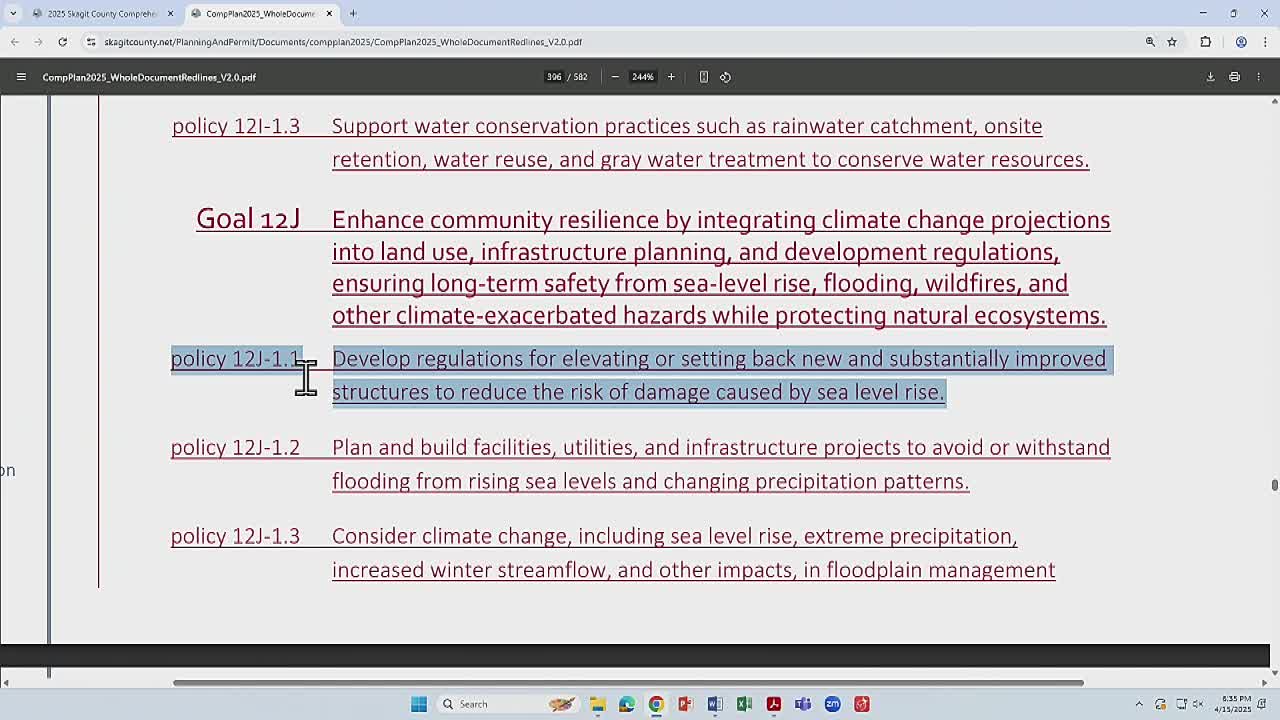Skagit County debates necessity of new flood regulation policies
April 15, 2025 | Skagit County, Washington
This article was created by AI summarizing key points discussed. AI makes mistakes, so for full details and context, please refer to the video of the full meeting. Please report any errors so we can fix them. Report an error »

Regulatory concerns took center stage at the Skagit County Planning Commission meeting on April 15, 2025, as members debated the implications of new floodplain regulations. A key discussion point revolved around the potential long-term impact of these regulations on property development and safety.
One commissioner expressed skepticism about hastily implementing regulations, stating, "I really don't like developing regulations willy nilly." This sentiment highlighted a broader concern that once regulations are established, they tend to persist, potentially leading to unnecessary constraints on property owners. The commissioner questioned the reliance on what he termed "best available science," suggesting that the proposed regulations might not be as effective as intended.
The conversation shifted to specific regulatory measures, including a proposal to set foundation heights based on projected high tide levels. The commissioner raised a hypothetical scenario where a house built 12 feet above a predicted tide might still be at risk if water levels only rise by 2 feet over the next 30 years. This example underscored the uncertainty surrounding climate projections and the challenges of creating effective regulations.
While some members acknowledged the need for regulations informed by FEMA maps, there was a clear divide on whether additional constraints would be beneficial or merely burdensome. One commissioner noted, "Are we adding a constraint that's unnecessary or not helpful?" This question encapsulated the ongoing debate about balancing safety with practicality in Skagit County's regulatory landscape.
As discussions continue, the Planning Commission faces the challenge of crafting regulations that protect residents while avoiding overly restrictive measures. The outcome of these deliberations will likely shape the future of development and environmental safety in the region.
One commissioner expressed skepticism about hastily implementing regulations, stating, "I really don't like developing regulations willy nilly." This sentiment highlighted a broader concern that once regulations are established, they tend to persist, potentially leading to unnecessary constraints on property owners. The commissioner questioned the reliance on what he termed "best available science," suggesting that the proposed regulations might not be as effective as intended.
The conversation shifted to specific regulatory measures, including a proposal to set foundation heights based on projected high tide levels. The commissioner raised a hypothetical scenario where a house built 12 feet above a predicted tide might still be at risk if water levels only rise by 2 feet over the next 30 years. This example underscored the uncertainty surrounding climate projections and the challenges of creating effective regulations.
While some members acknowledged the need for regulations informed by FEMA maps, there was a clear divide on whether additional constraints would be beneficial or merely burdensome. One commissioner noted, "Are we adding a constraint that's unnecessary or not helpful?" This question encapsulated the ongoing debate about balancing safety with practicality in Skagit County's regulatory landscape.
As discussions continue, the Planning Commission faces the challenge of crafting regulations that protect residents while avoiding overly restrictive measures. The outcome of these deliberations will likely shape the future of development and environmental safety in the region.
View full meeting
This article is based on a recent meeting—watch the full video and explore the complete transcript for deeper insights into the discussion.
View full meeting
